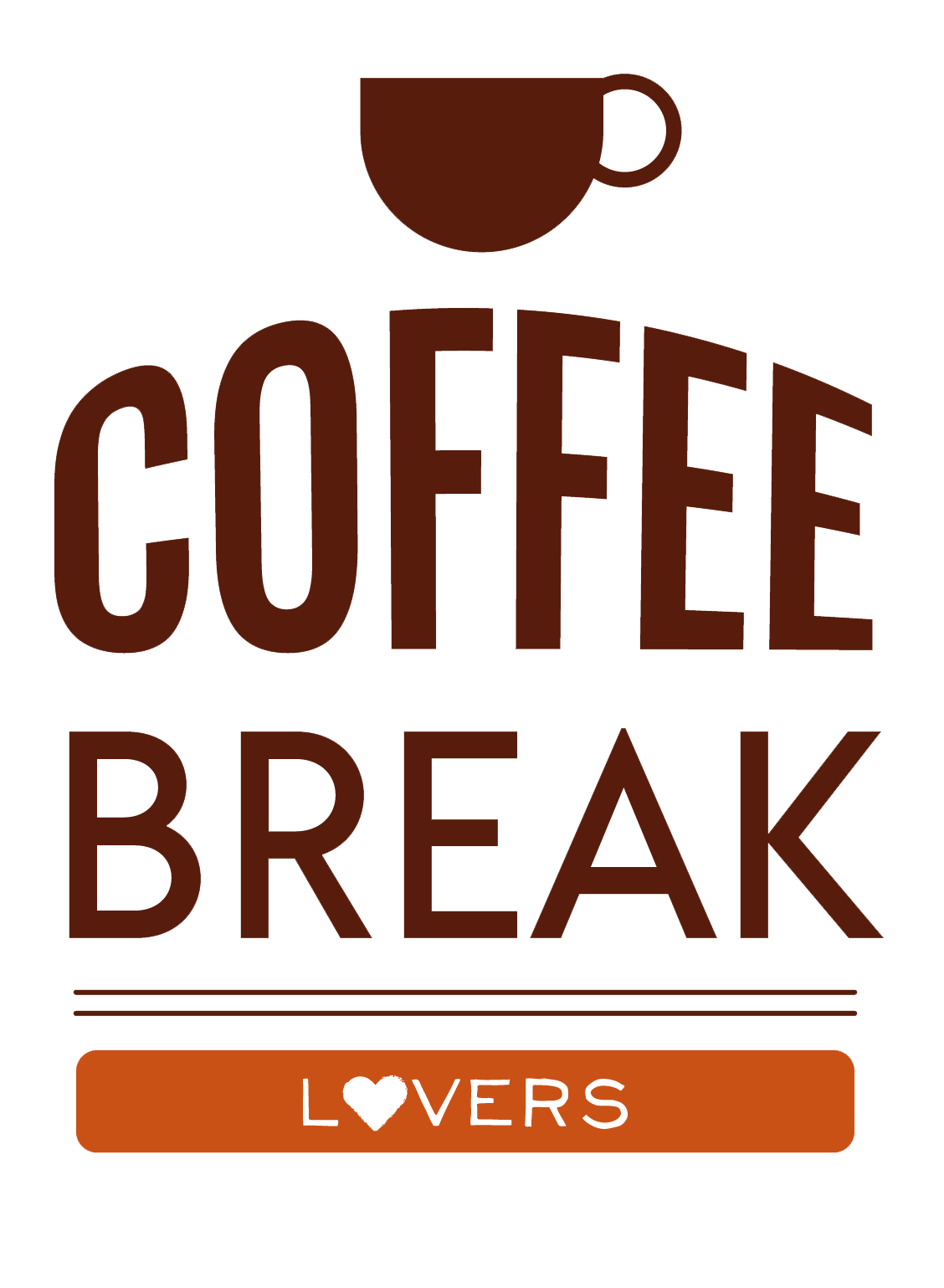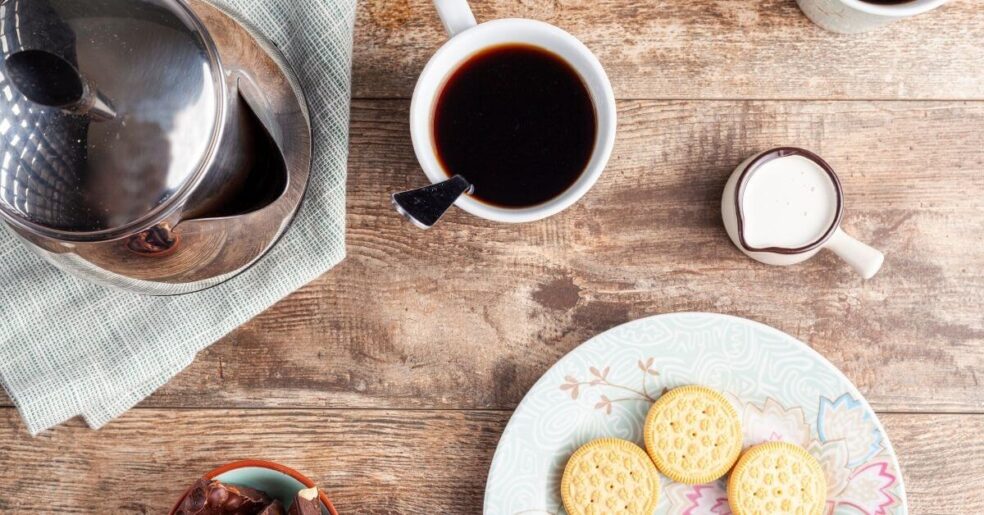Conventional wisdom says that boiled coffee is spoiled coffee. But that’s exactly how the old-fashioned stovetop percolator works – by boiling your coffee over and over again!
Despite this, coffee percolators were extremely popular back in the day. And while they’re not as common as they used to be, coffee percolators still have their diehard fans!
If you’re looking to buy a top-notch percolator, we recommend the Farberware Yosemite Coffee Percolator. It’s made of high-quality stainless steel, it’s large enough to brew for the whole family, and it’s very well-rated!
But if you really want to know more about this coffee brewing method, stick around! In this post, we’re going to talk about
- The history of stovetop percolators and how they work,
- How to brew coffee with a stovetop percolator,
- Some more of the best coffee percolators on the market
Let’s jump right in!
Shop For Related Products
What is a Stovetop Percolator?
A stovetop percolator is a type of coffee pot that cycles boiling water through coffee grounds continuously until you remove it from the heat.
Percolators are basically kettles that contain a perforated coffee basket at the top and a tube. The basket is there to hold the ground coffee beans and the tube allows the boiling water to rise from the bottom of the kettle to the top.
Most percolators have a glass knob on top so you can see when the percolation process begins.
After the bubbling water spouts out on the coffee grounds, the brewed coffee drips through the basket and falls back to the bottom of the kettle.
There, the coffee is heated again, rises through the tube again, and drips through the coffee grounds…again.
This process happens over and over again until you remove the kettle from the heat.
Related Posts:
Best Coffee Percolators
1. Farberware Yosemite Coffee Percolator
The Farberware Yosemite Coffee Percolator is one of the highest-rated percolators you’re likely to find! It has an 8-cup capacity, so it’s not the largest, but it can still prepare enough for a group.
It’s an amazing little pot that’s made specifically for stovetop. And the glass knob lets you see exactly when percolation starts so you can get the brew right.
The pot is made of durable stainless steel that’s easy to clean and is dishwasher safe. Its permanent filter basket means you never have to worry about dealing with messy coffee filters.
All in all, this is our #1 recommendation if you’re looking for the best coffee percolator!
2. Coletti Bozeman Camping Coffee Pot
The Coletti Percolator has a 9-cup capacity, so it’s slightly larger than the Farberware Percolator. It also comes with measuring lines so you can easily tell how much coffee you’re brewing.
This classic percolator was engineered for outdoor use, so it’s simple, efficient, and ready to brew a cup of hot coffee wherever you are. If you’re a camper this one is definitely for you!
When it comes to design, the Coletti percolator is made from quality materials. It has a hardwood handle, a stainless steel body, and a tempered glass knob.
It’s definitely built to last!
3. Presto 02811 12-Cup Stainless Steel Coffee Maker
The Presto Percolator is another one of the best coffee makers on the market. It can make from 2 to 12 cups, and it’s very easy to use!
This percolator is an electric model, so it’s made for indoor. But it operates just like the traditional stovetop percolator. It makes a delicious coffee then keeps it piping hot for quite a while.
This one is also made of durable stainless steel, but since it’s electric, it comes with a signal light to indicate when the coffee is ready.
If you love percolator coffee but don’t want to use the stove or a campfire, check out Presto’s Electric percolator coffee pot.
4. Hamilton Beach 12 Cup Electric Percolator Coffee Maker
Hamilton Beach’s electric coffee percolator is another highly-rated coffee maker. It has a 12-cup capacity and is the perfect choice for brewing rich coffee in the morning!
But not only that, but it’s also great for boiling up to 12 cups of water for hot chocolate, tea, or anything else.
This percolator coffee pot is also made from durable stainless steel and is very easy to clean.
Unlike traditional percolators, the Hamilton Beach coffee maker has a cool-touch handle, so you don’t have to worry about burning yourself when serving your coffee.
5. Coleman 12-Cup Stainless Steel Coffee Percolator
Coleman’s Coffee Percolator is another coffee maker that’s perfect for camping trips or outdoor brewing. It is made from rust-resistant stainless steel, so it will last for a long time and be easy to clean.
This percolator includes a base, tube, basket filter, and basket lid. It also has a 12-cup capacity that makes it perfect for big groups and is lightweight despite its large capacity.
The Coleman is a well-received brewer that’s known for making some of the best percolator coffee around.
History of Coffee Percolators
The first version of the stovetop coffee percolator was made by Joseph-Henry-Marie Laurens in Paris in 1819. This first version contained many of the features we’re familiar with today.
Namely, it contained a tube so that boiling water could rise from the bottom of the pot to the top. It also allowed the water to continuously cycle through the coffee grounds. Lastly, it was made to be heated on a kitchen stove.
Laurens’ percolator was adapted and modified over time, but the basic features remained the same. A few decades later, in 1865 the first US patent for the coffee percolator was issued to James Nason.
Then, in 1889, Hanson Goodrich patented his stove-top percolator system. It had all the required elements – a base for boiling, a tube to carry the boiling water upward, and a perforated basket.
The unique thing about Goodrich’s design is that it could turn any standard coffee pot into a stovetop percolator.
Percolators enjoyed wide popularity through the 20th century up until the 1970s when it was overtaken by the automatic drip coffee maker.
Do Percolators Make Good Coffee?
Yes, coffee percolators can make a good cup of Joe! It won’t have the delicate flavors and aromas associated with specialty coffee. But it will be just fine if you don’t overcook it!
This question often comes up because of how easy it is to make over-extracted and bitter coffee with this coffee brewing method. But percolator enthusiasts swear they make the best coffee!
But regardless of what critics or enthusiasts say, the answer to whether a stovetop percolator makes “good” coffee depends on you.
If you prefer a milder cup of coffee, run your percolator for only a short time. Or, let it run longer for a more robust cup of coffee.

Electric Percolator vs Stovetop Percolator
So, you’re thinking about buying a coffee percolator, but you’re not sure whether you want a stovetop or an electric percolator?
There are a few reasons to choose one or the other. Let’s tackle the benefits of stovetop percolators first.
Stovetop Percolators
The stovetop percolator is the original version of this brewer. They were made to be heated on stovetops or open flames (since they were invented before electricity was available!)
This makes them an excellent option for people who may be without electricity, like campers, or people who just prefer brewing coffee on the stove.
Also, because stovetop percolators don’t have any electrical components, they’re easy to clean.

Electric Percolators
Electric percolators are relatively newer. There are conflicting claims, but it’s almost certain that the first electric coffee percolator was invented in the early to mid 20th century.
Electric percolators are great for people who want to brew coffee in the office or in their kitchen without having to use the stove.
Many models have timers, and automatic shutoff options, so you never have to worry about brewing longer than you should.
The downside is that electric percolators tend to be more expensive than the stovetop versions. And of course, they can only be used where electricity is available.
Does Percolator Coffee Taste Better Than Other Brews?
Some people swear that percolator coffee is the best, others say that it’s too strong and bitter. But whether percolator coffee tastes better than other brewing methods depends on what you like.
For example, if you prefer a regular cup of Joe, similar to what you’d get at a restaurant or roadside diner, then yeah…percolator coffee may be better.
On the other hand, if you’re someone who wants to enjoy the complex flavor profiles and aromas, then you may want to go with another brewing method.
The only way to answer this question definitively is to experiment with different brewing methods and see what you like best!
But what we can do here is compare and contrast a few brewing methods and compare them to the percolator.

Percolator vs Moka Pot
In a nutshell, choose a Moka pot if you prefer strong espressos. Choose a percolator if you prefer a less concentrated cup of coffee.
Although their coffee tastes different, stovetop percolators and Moka pots have a few things in common:
- they’re traditionally stovetop coffee makers
- they were extremely popular in the early to mid 20th century (although the popularity of percolators declined, Moka pots are still going strong!)
But this is where the similarities end though since their brewing systems are quite different!
The Moka Pot uses steam pressure to pass water through fine coffee grounds only once. This method extracts a lot of coffee flavors which results in a very robust cup.
By comparison, the percolator uses coarse grounds and continuously brews the coffee. This can result in over-extraction, but typically percolator coffee is not as bold as Moka Pot coffee!
Related Posts:
- 6 Siphon Coffee Maker To Create A Unique Coffee Experience
- Breville vs Delonghi. Best Espresso Machine 2021
- Best way To Grind Coffee: For The Perfect Cup Of Coffee!
- Turkish coffee Grinder: How To Choose The Best!
Percolator vs Pour Over
The pour-over brewing method is ideal for a small amount of specialty coffee where you’re looking to emphasize the bean’s natural flavors. While percolators are great for brewing large pots of non-specialty coffee.
The pour-over method is a manual brewing method that’s usually done on a kitchen countertop.
With the pour-over method, you’re basically pouring hot water over ground coffee in a filter. The coffee then drips through the filter and into a cup or pot below.
Unlike the percolator, this method puts you in complete control of the brewing process and allows you to bring out the bean’s complex flavors.
The big drawback of this method is that it takes time and attention to brew a proper pour-over. You may find the process to be a bit much if you just want a quick cup of Joe!
Compared to the pour-over, percolators can make large amounts of coffee and they’re a lot less work. But the end result is a cup of coffee without the complex flavors and aromas that coffee connoisseurs enjoy.
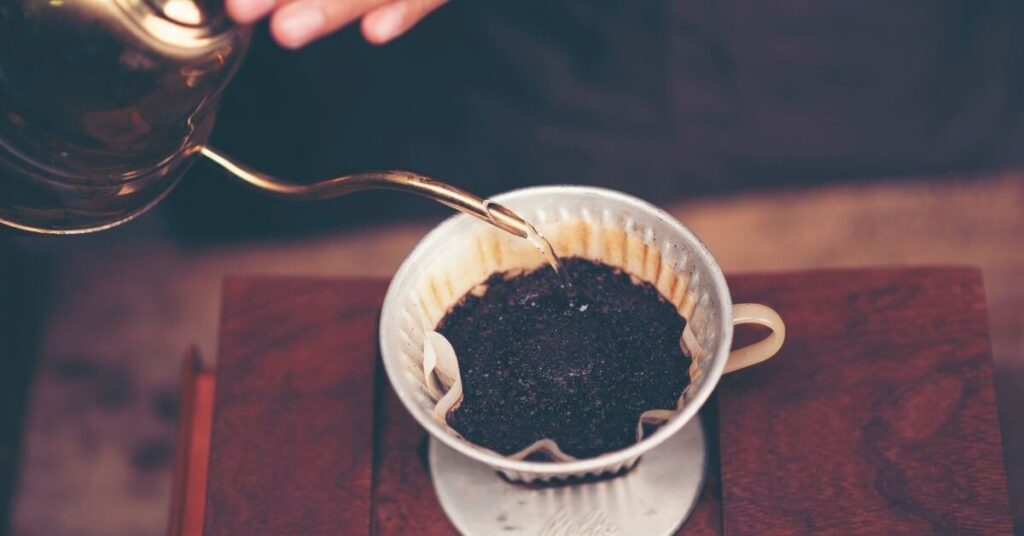
Percolator vs Drip Coffee
Drip coffee makers are better if you want to brew large amounts of coffee with minimum effort. But choose a percolator if you want a hotter, stronger cup that can be brewed on the stove or over a campfire.
A drip coffee maker is essentially an automatic pour-over. So, many of the differences between the percolator and drip machine are similar to the pour-over.
But there are some similarities worth mentioning! For starters, they’re both meant to be relatively easy to use! With both drip makers and percolators, you can put in your coffee grounds, add water and let the machine do most of the work.
Drip makers and stovetop percolators are also meant to make large amounts of coffee at one time. So if you’re making coffee for a group, these are great brewing methods.
Now, for the other differences.
- Drip makers are all electric while traditional percolators are stovetop
- They use paper filters, which may alter your coffee’s flavor
- Most automatic drip machines heat water to the optimum temperature, unlike percolators which boil the water
So, if you prefer an automatic method that will brew a milder cup, then drip makers may work best for you. Or, if you prefer an easier-to-clean, filter-free option, give the percolator a try.
Percolator vs French Press
The French Press is an excellent method for bringing out the coffee’s complex flavors and aromas. While percolators are better for brewing regular coffee for a large group.
The French Press method uses immersion brewing, which means the beans are allowed to steep in a container of hot water. Because of this, much of the bean’s oils and flavors remain in the final cup of coffee.
With a stovetop percolator, however, much more of the coffee’s flavors are thrown out with the grounds.
Additionally, since you preheat the water for the French Press, you’re less likely to over-extract the coffee.
The French Press is another one of those methods that’s phenomenal for specialty coffees, and people who want a more ritualized coffee brewing process.
Related Posts:
- Best Espresso Machine Under 200 Dollars
- Best Blender For Bulletprooof Coffee: The Most Comple Guide 2021!
- Moka Pot vs French Press: Whose Coffee Is Best?
Percolator vs Middle Eastern Coffee
The preparation of Middle Eastern coffee has almost nothing in common with percolator coffee.
with Middle Eastern coffee:
- very fine coffee grinds are used
- the grounds are immersed in the water and boiled.
- a small amount of coffee is brewed
- coffee grinds remain in the cup of coffee
These factors give Middle Eastern coffee a strong and bitter flavor. And spices like cardamom or saffron are often added to enhance the flavor.
Middle Eastern coffee is usually served in small cups or glasses, often without cream or sugar.
This is completely different from the regular cup of coffee that comes from out of a percolator! And the process and equipment needed definitely make it a specialty drink for the average U.S. coffee drinker!

How do you use a Stovetop Percolator?
Brewing with a coffee percolator is extremely easy! All you need is
- a percolator,
- ground coffee,
- and water
Here’s how to get started!
1. Prepare Your Coffee Grounds
When using a percolator, you want to use coarsely ground beans. If you use grounds that are too small, they can slip through the perforated filter basket and end up in your coffee!
Pro Tip: You can cut a small hole in the middle of a paper coffee filter and place it in the percolator’s filter basket to prevent coffee grinds from falling through.
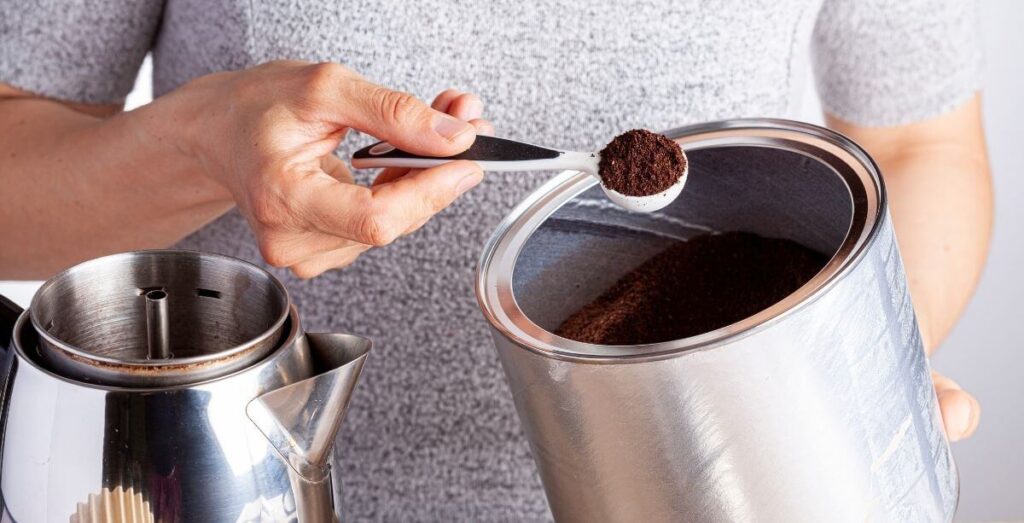
2. Prepare Your Percolator
Your next step will be to prepare the percolator itself. Make sure you clean it out and remove any leftover grounds from your previous brew before proceeding.
If you don’t, it could definitely affect the flavor of your coffee!
Then, add water to the reservoir, add your coffee grounds to the basket and make sure everything is screwed into place.
3. Put Your Percolator On The Heat
When heating your percolator make sure you put it on medium to medium-low heat. If you don’t, you may wind up with burnt-tasting coffee.
Many percolators have a glass knob on top that allows you to monitor the brewing.
If you don’t see any bubbles forming through the glass knob, the water is still too cool. But if you see a rapid sequence of bubbles, the water is boiling and is too hot.
The ideal situation is where you see one bubble every few seconds.
Pro Tip: Glass knobs are better than plastic knobs. Plastic can alter your coffee’s flavor if the temperature gets too hot.

4. Let It Percolate
Once bubbles start forming, adjust the heat so that the temperature is maintained. At this point we recommend you hang around to keep an eye on the brewing.
Keep in mind that percolators continuously cycle the coffee through the ground coffee, so the longer it runs, the strong your coffee will be.
We recommend letting your percolator run for about 5 to 10 minutes, depending on how strong you want it.
Pro Tip: Pay attention to the time. That way, if you absolutely love how your coffee came out, you can set a timer for a consistent brew.
##Discard the grounds and enjoy your coffee
Remember that the coffee and the percolator itself are hot! So, use oven mitts to remove the grounds.
Some coffee drinkers recommend letting the coffee sit for a few minutes before serving. The reason is that some coffee grounds may have fallen into the coffee and this will give them some time to settle to the bottom.
After that, you’re ready to enjoy your coffee!
Pros Of The Stovetop Percolators
There are several benefits to using a stovetop coffee percolator. Most percolator enthusiasts site one of these as their reason for choosing a percolator.
- They have an old-fashioned, nolstalgic look that some people love.
- The coffee remains very hot after being percolated. Much hotter than drip coffee!
- It’s versatile and can be used on a stove or outdoors over a fire
- It’s simple design makes for easy cleaning
- The flavor is rich and delicious when brewed correctly
- The coffee percolator has a large capacity and can brew enough coffee for a group
Cons of Stovetop Percolators
There are also some things to look out for when working with coffee percolators. Keep these in mind when deciding whether or not a percolator is right for you:
- Water is often too hot when it hits the ground coffee
- Some coffee grinds can wind up in the coffee
- They require a stove or fire, which might not be practical in some situations
- The coffee can sometimes taste burnt and over-extracted.
- There is also the risk of getting burned while brewing or serving if you don’t use oven mitts
Shop For Related Products
Stovetop Percolator: The Bottom Line
Stovetop percolators are an old-fashioned brewing method that sometimes gets a bad rap. But their versatility, brewing capacity, strong flavor make it popular among some coffee drinkers today.
If you’re looking for a good cup of Joe, a percolator will work great for you. We recommend The Farberware Yosemite Coffee Percolator if you prefer stovetop models. Or the Presto 02811 if you’re looking for an electric version.
Either way, you’ll end up with a delicious cup of percolated coffee!
However, if your main concern is to maintain or enhance the bean’s natural flavors, the pour-over or French Press methods will work better.
The bottom is, whichever coffee you like best is best, regardless of what people say. So, try several different brewing methods to find out what you like!
Cheers, coffee lovers!

- Why Does My Moka Pot Sputter? (And 6 Easy Ways To Fix It!)
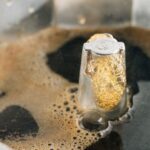
- What’s The Best Induction Moka Pot? (Top 5 Picks!)

- What Are The Parts Of A Moka Pot? (Easy Assembly Guide!)
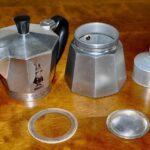
- Turkish Coffee Grinder-How To Choose The Best!


Oliver is co-owner of Coffee Break Lovers. The only thing he loves more than the process of brewing coffee is drinking it.
